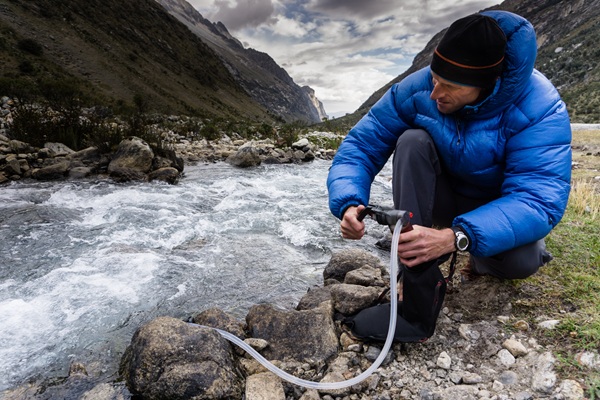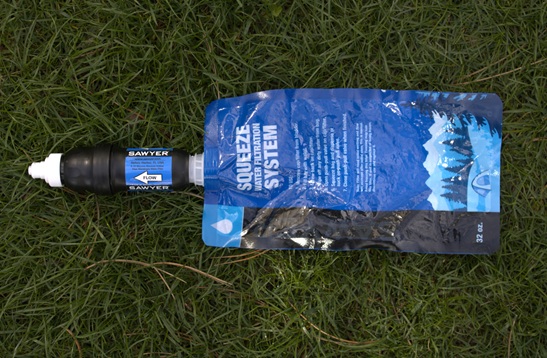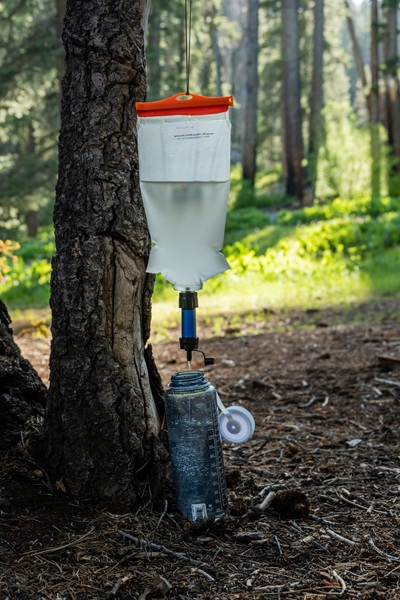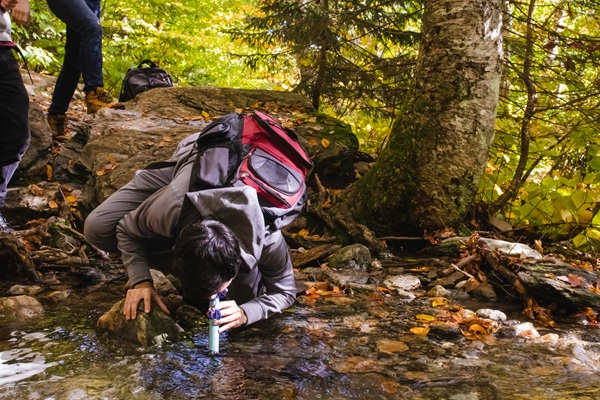Learn about Water Treatment for Backpacking

Table of Contents
Never assume water is safe to drink untreated. Even clear and pristine streams flowing directly from mountain snowmelt may be contaminated with pathogens from animal feces. That’s why Giardia is called “beaver fever.”
Running water is safer than stagnant water. Avoid collecting water near human and animal activity.
There are 4 ways to treat water:
- Boiling
- Filtration
- Chemical Disinfectants
- UV Light
Although these treatment methods kill most pathogens, they don’t remove heavy metals, radioactive materials, or toxic chemicals. Even in remote public lands, water can be contaminated by chemicals left over from past mining, petroleum extraction, or spills. Before your backpacking trip, research whether the water is safe to drink.
Always carry a backup water-treatment system. I recommend using a stove as your backup. Boiling inactivates all pathogens1, and you can use the stove for cooking.
Boiling
Boiling is the most effective water treatment—it even inactivates most viruses.1 It’s the safest option in areas with human or animal activity.
If the water is muddy or cloudy, filter it through a cloth or water filter before boiling. Bring the water to a rolling boil for at least 1 minute. At elevations above 6,500 feet, boil it for 3 minutes1. Water boils at lower temperatures at high altitudes.
The disadvantage of boiling is that you must drink hot water or wait for it to cool.
Filtration
Filtration is the most popular option. Water filters remove protozoa and most bacteria, but not viruses1. Your filter must have an absolute pore size of 0.3 microns or smaller to remove bacteria 1.
If the water is muddy or cloudy, pre-filter it through a cloth to prevent it from clogging your filter. Also, backflush the filter before and after long-term storage or when the filtration rate decreases. Some water filters include a syringe for backflushing.
Be careful not to let any untreated water drip into your clean water during filtering. If using a squeeze filter, hold it at an angle that prevents dripping into your clean water.
If your water filter freezes, it will fail, even after it thaws. On cold nights, put your filter in a Ziploc bag and keep it with you in your sleeping bag to prevent freezing. While hiking at freezing temperatures, carry your filter under your clothes, close to your body.
Types of filters:
- Squeeze filter
- Pump filter
- Gravity filter
- Bottle filter
Squeeze Filter

You attach the filter to a container filled with untreated water and then squeeze the water through the filter into another container. This method takes time and effort.
Pump Filter

You connect the filter to a hose, place the hose in the water source, and pump the water through the filter.
Gravity Filter

A “dirty water” bag, a filter, and a “clean water” container are connected to each other, usually by a hose. You fill the “dirty water” bag and hang it from a tree branch. Gravity draws the water through the filter and into the “clean water” container. Although this method takes time, you can leave it to work by itself while you do other tasks.
A squeeze filter can also be configured as a gravity filter.
Straw Filter

You suck dirty water from the source through the filter with your mouth like a straw. Straw filters are less versatile than other systems because they don’t allow you to store clean water.
Bottle Filter
You fill a soft plastic bottle with dirty water. You can either squeeze the water out through the filter or suck it out with your mouth.
Chemical Disinfectants
Chemical disinfectants kill bacteria, viruses, and Giardia but are less effective than filters and boiling against Cryptosporidium1. They take at least 30 minutes to work1.
Because these chemicals are poisonous, always follow the package instructions carefully to ensure correct dilution. The CDC provides dilution instructions here.
There are 3 common chemical disinfectants:
- Chlorine dioxide
- Chlorine bleach (sodium hypochlorite)
- Iodine
I recommend chlorine dioxide because it’s tasteless and kills Giardia more reliably than bleach or iodine.1,2 However, chlorine dioxide is not completely reliable against Cryptosporidium.1,2
Iodine is unsafe for pregnant women and people with thyroid problems or iodine hypersensitivity.1,2 It’s not safe to use for more than a few weeks.1,2
UV Light
Effectiveness of Water Treatment Methods
| Pathogen | Boiling 1-3 minutes | Filtration | Chlorine Dioxide | Bleach | Iodine | UV light, clear water |
|---|---|---|---|---|---|---|
| Bacteria | Effective | Effective | Effective | Effective | Effective | Effective |
| Viruses | Effective | Not effective | Effective | Effective | Effective | Effective |
| Giardia | Effective | Effective | Effective | Unreliable | Unreliable | Effective |
| Cryptosporidium | Effective | Effective | Unreliable | Not effective | Not effective | Effective |
Pros and Cons of Water Treatment Methods
| Method | Pros | Cons | Example |
|---|---|---|---|
| Boiling | Kills bacteria, viruses, and protozoa Reliable | Water may need to be prefiltered to remove particles Uses up stove fuel Water is hot | |
| Squeeze Filter | Removes bacteria and protozoa Removes particles Small Lightweight | Doesn’t remove viruses Slow Ineffective after being frozen Can become clogged Must be periodically flushed | Sawyer Squeeze |
| Pump Filter | Removes bacteria and protozoa Removes particles Easier than squeeze filters | Heavy Bulky Doesn’t remove viruses Slow Ineffective after being frozen Can become clogged Must be periodically flushed | MSR Guardian |
| Gravity Filter | Removes bacteria and protozoa Removes particles Doesn’t require squeezing or pumping Good for groups | Heavy Bulky Doesn’t remove viruses Very slow Ineffective after being frozen Can become clogged Must be periodically flushed | Platypus GravityWorks |
| Straw Filter | Removes bacteria and protozoa Removes particles Can drink directly from water source | Doesn’t allow you to store clean water Slower than squeeze or pump filters | LifeStraw |
| Chlorine Dioxide | Kills bacteria, viruses, and Giardia Tasteless Small Lightweight Affordable | Limited effectiveness against Cryptosporidium Takes 20-30 minutes to become effective Poisonous if concentration is too strong Water may need to be prefiltered to remove particles | Aquamira |
| Bleach (sodium hypochlorite) | Kills bacteria, viruses, and Giardia Small Lightweight Affordable | Doesn’t kill Cryptosporidium Takes 20-30 minutes to become effective Poisonous if concentration is too strong Water may need to be prefiltered to remove particles Tastes bad | Chlorox |
| Iodine | Kills bacteria, viruses, and Giardia Small Lightweight Affordable | Doesn’t kill Cryptosporidium Takes 20-30 minutes to become effective Tastes terrible Water may need to be prefiltered to remove particles Poisonous if concentration is too strong Not safe for pregnant women or people with thyroid problems Not safe to use longer than a few weeks | Potable Aqua |
| UV Light | Inactivates all pathogens Easy to use Fast-acting | Doesn’t work in cloudy water Water may need to be prefiltered to remove particles Requires batteries or charging May fail Batteries can die | Steripen Ultra |
Other Precautions
Don’t store clean water in an unwashed container that previously contained untreated water.
Many cases of illness attributed to contaminated water are caused by poor hygiene. Because backpackers often have limited hygene on the trail, objects that they touch–such as gates, ladders, iron rungs, grip cables, and tree branches–can become contaminated. If possible, wash your hands with soap and water after pooping and before eating or preparing food. If handwashing isn’t possible, use hand sanitizer that contains at least 60% alcohol. Don’t wash fruit or vegetables with untreated water.
Bury your poop 8 inches deep at least 200 feet away from water.
